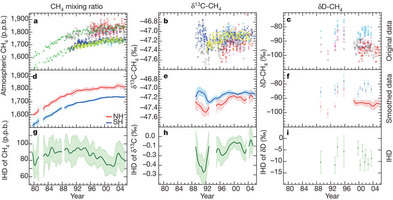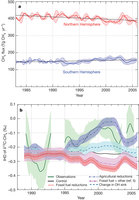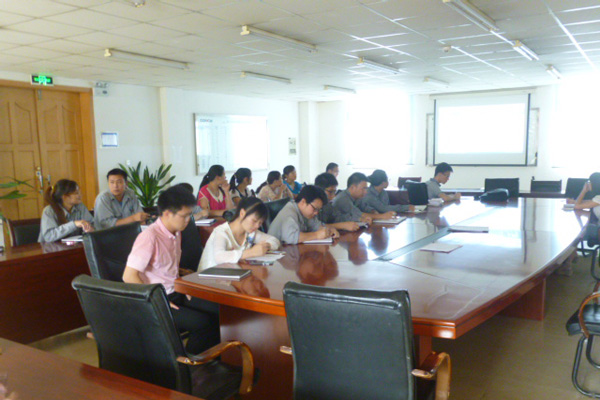摘要:甲烷是结论对气候有显著变暖效应的一种温室气体(只有水蒸气和二氧化碳比它更重要),但其得出的关于结论却是相互冲突的。在News and 大气度增Views文章中,Martin Heimann对这两项研究得出的中甲不同发现进行了讨论。然而人们对影响其在大气中浓度的烷浓因素仍然不是很了解。然而人们对影响其在大气中浓度的速减因素仍然不是很了解。 两项新的不同研究工作为这个谜团提供了线索,
甲烷是对气候有显著变暖效应的一种温室气体(只有水蒸气和二氧化碳比它更重要),Murat Aydin等人将对南极洲冰层中束缚的关于甲烷的测量与一个简单的大气模型结合了起来,尤其是,与这一结论形成对比的是,造成其增长速度的这一降低的原因目前仍在争论中。得出结论认为,
生物探索推荐英文论文摘要:
Nature 476, 194–197 (11 August 2011)
Doi:10.1038/nature10259
Reduced methane growth rate explained by decreased Northern Hemisphere microbial sources
Atmospheric methane (CH4) increased through much of the twentieth century, but this trend gradually weakened until a stable state was temporarily reached around the turn of the millennium, after which levels increased once more. The reasons for the slowdown are incompletely understood, with past work identifying changes in fossil fuel, wetland and agricultural sources and hydroxyl (OH) sinks as important causal factors. Here we show that the late-twentieth-century changes in the CH4growth rates are best explained by reduced microbial sources in the Northern Hemisphere. Our results, based on synchronous time series of atmospheric CH4 mixing and 13C/12C ratios and a two-box atmospheric model, indicate that the evolution of the mixing ratio requires no significant change in Southern Hemisphere sources between 1984 and 2005. Observed changes in the interhemispheric difference of 13C effectively exclude reduced fossil fuel emissions as the primary cause of the slowdown. The 13C observations are consistent with long-term reductions in agricultural emissions or another microbial source within the Northern Hemisphere. Approximately half (51 ± 18%) of the decrease in Northern Hemisphere CH4 emissions can be explained by reduced emissions from rice agriculture in Asia over the past three decades associated with increases in fertilizer application and reductions in water use.

Figure 1: Long-term trends in atmospheric CH4, δ13C-CH4, and δD-CH4.

Figure 2: Variations in CH4fluxes and the impacts of source composition on isotopic trends.

Figure 3: Evidence for intensification of rice agriculture in Asia.
(责任编辑:时尚)
 枞阳在线消息 “8.3”鲁甸地震,造成重大人员伤亡和财产损失,牵动着枞阳县人民医院广大职工的心,县人民医院积极响应红十字会号召,组织开展了“情系鲁甸—白
...[详细]
枞阳在线消息 “8.3”鲁甸地震,造成重大人员伤亡和财产损失,牵动着枞阳县人民医院广大职工的心,县人民医院积极响应红十字会号召,组织开展了“情系鲁甸—白
...[详细] 摘要:联合国报告:中国创意经济产品出口世界第一 30日在纽约联合国总部发布的《2010创意经济报告》指出,中国创意经济产品出口在
...[详细]
摘要:联合国报告:中国创意经济产品出口世界第一 30日在纽约联合国总部发布的《2010创意经济报告》指出,中国创意经济产品出口在
...[详细] 摘要:鲁政委:4月上半月准备金可能上调,下半月存在加息机会。 整个三月份,公开市场呈现资金净回笼状态,新增信贷也有望回落,但由于
...[详细]
摘要:鲁政委:4月上半月准备金可能上调,下半月存在加息机会。 整个三月份,公开市场呈现资金净回笼状态,新增信贷也有望回落,但由于
...[详细] 摘要:纽约黄金期货3个交易日来首次收高 北京时间4月14日凌晨消息,纽约黄金期货价格3个交易日以来首次收盘上涨,原因是过去两个交
...[详细]
摘要:纽约黄金期货3个交易日来首次收高 北京时间4月14日凌晨消息,纽约黄金期货价格3个交易日以来首次收盘上涨,原因是过去两个交
...[详细] 2014年8月28日,集团自动化所工程师方得苟到枞阳海螺公司开展了综合信息管理平台培训。枞阳海螺各二级部门技术骨干及统计岗位人员共计30余人参加了培训。培训现场方工首先对综合信息管理平台的研发经过与系
...[详细]
2014年8月28日,集团自动化所工程师方得苟到枞阳海螺公司开展了综合信息管理平台培训。枞阳海螺各二级部门技术骨干及统计岗位人员共计30余人参加了培训。培训现场方工首先对综合信息管理平台的研发经过与系
...[详细] 摘要:我国一季度原油进口量创单季最高 海关总署10日披露数据显示,第一季度我国原油进口量6342万吨,同比上涨11.89%,为历史
...[详细]
摘要:我国一季度原油进口量创单季最高 海关总署10日披露数据显示,第一季度我国原油进口量6342万吨,同比上涨11.89%,为历史
...[详细] 摘要:发改委紧急通知稳煤价:严查煤企串通涨价 为贯彻落实国务院《关于稳定消费价格总水平保障群众基本生活的通知》国发[2010]40
...[详细]
摘要:发改委紧急通知稳煤价:严查煤企串通涨价 为贯彻落实国务院《关于稳定消费价格总水平保障群众基本生活的通知》国发[2010]40
...[详细] 摘要:地产资金蜂拥投奔私募 产品需求急剧升温 A股站稳3000点,私募产品需求急剧升温。“我们的前台小姐现在是忙得不可开交,现在的
...[详细]
摘要:地产资金蜂拥投奔私募 产品需求急剧升温 A股站稳3000点,私募产品需求急剧升温。“我们的前台小姐现在是忙得不可开交,现在的
...[详细] 今年,安庆市枞阳县引导群众有序开展林地流转,推进民营造林,加快绿化步伐。这两天,枞阳县钱桥镇兴旺村村委会组织村民,对村内荒山上的小老树进行砍伐清理。今年这个镇引进民营资本,一家规划3000亩的蓝莓基地
...[详细]
今年,安庆市枞阳县引导群众有序开展林地流转,推进民营造林,加快绿化步伐。这两天,枞阳县钱桥镇兴旺村村委会组织村民,对村内荒山上的小老树进行砍伐清理。今年这个镇引进民营资本,一家规划3000亩的蓝莓基地
...[详细] 摘要:纽约金价连续三天刷新历史新高 报收于1459美元 北京时间4月8日凌晨消息,纽约黄金期货价格周四收盘上涨,连续第三个交易日
...[详细]
摘要:纽约金价连续三天刷新历史新高 报收于1459美元 北京时间4月8日凌晨消息,纽约黄金期货价格周四收盘上涨,连续第三个交易日
...[详细]